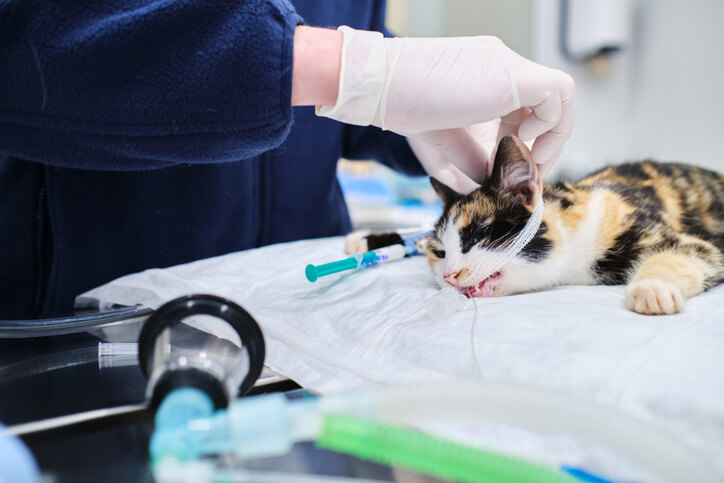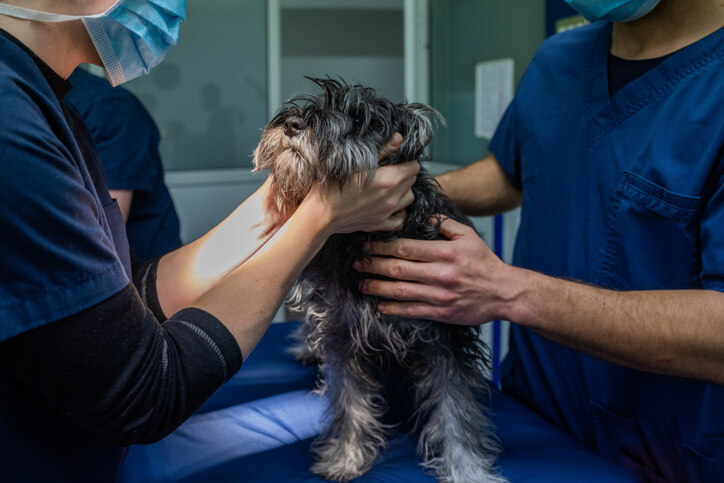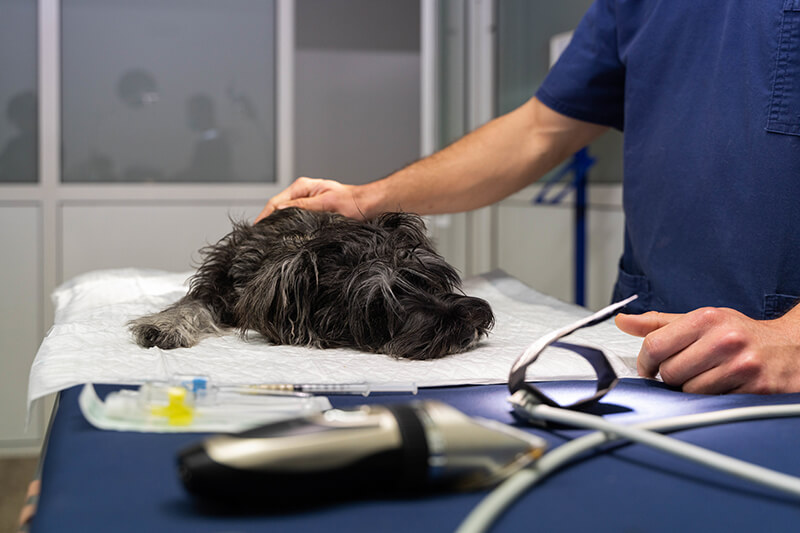Ultimate Guide to Pet Foreign Body Emergencies
Cats and dogs alike have a knack for chewing on things that they’re not supposed to get into. But swallowing those items elevates the situation from a nuisance to a potentially life-threatening problem. When an animal ingests a foreign body, they may need surgery to get it removed.
Nationwide pet insurance reports foreign body ingestion as one of its most common claims. As of 2018, policyholders filed more than $11.5 million in claims for foreign body ingestion for dogs and cats combined.
That’s a scary reality for any pet owner, but it’s a highly realistic situation you need to be prepared for. In this article, we’ll tell you everything you need to know about foreign body removal surgery. We’ll discuss signs your pet may have ingested something, treatment options, and more.
Everything You Need to Know About Foreign Body Surgeries

What are the Signs that Your Pet Ingested a Foreign Body?
You can’t watch your animals at all times. You may have to leave your dog at home when you go to the office, or maybe your cat wanders around the house in the middle of the night while you’re sleeping. So it’s important to keep an eye out for the signs that your pet may have ingested something while you weren’t looking. Here are some signs to look out for.
If you catch your cat or dog right after they swallow something, they may start choking. If your pet is retching/gagging, coughing, pawing at their mouth, or rubbing their face against the ground, they may be choking. Try to remove the item from your animal’s mouth, or perform the Heimlich Maneuver.
An upset stomach is one of the clearest signs that your animal has swallowed a foreign object. It will also be one of the first symptoms to present itself. If your pet is vomiting, has diarrhea, has loss of appetite or nausea, or extreme salivation, they may be experiencing gastrointestinal distress from ingesting a foreign object.
If your pet ate something sharp or splintery, the item may cause internal bleeding to their esophagus or GI tract. If your animal has pale gums, a racing heart, lethargy, or is coughing up blood, get in touch with your veterinarian right away.
Your dog or cat’s bathroom behavior is an important indicator of how they’re feeling. Straining to defecate, diarrhea, uncontrolled urination or a noticeable increase in drinking are signs that something may be off.
The sounds or behavior your pet exhibits may be a clear sign they’re experiencing discomfort from swallowing a foreign object. These changes will be more obvious with dogs. For example, bending forward and sticking their backside in the air is a sign their stomach is upset. They’re trying to relieve pressure from the area.
They may also grunt, moan, or whine. A cat’s behavior can be more challenging to decipher. But if your cat is usually even-keeled, and they start hissing or biting when being picked up, that’s a sign that something hurts.
As soon as you see any symptom that your pet has swallowed a foreign object, take them to the vet. It’s important to get your animal checked out right away, even if you were able to remove the object.

What are Commonly Swallowed Objects?
If it’s small enough, a dog or cat can swallow anything. But there are some items that are more commonly swallowed by household pets than others. If you have any of the following items in your home, do your best to keep them out of your cat or dog’s reach.
- Balloons
- Batteries
- Bones
- Chapstick/lipstick
- Cigarettes
- Cough drops
- Food wrappers (aluminum or plastic)
- Fruit seeds/pits
- Gum
- Pencils/pens
- Plastic
- Rocks
- Rubber bands/hair ties
- Silica gel packets
- Socks
- String
- Tampons
- Toys/squeakers/tennis balls
The risks from these items range from being a choking hazard, to a puncture risk, to an intestinal blockage, or being poisonous to cats or dogs. If your pet swallows any of the items on this list, that is an emergency situation that requires an examination by your veterinarian.
But keep in mind that this is not an all-inclusive list. Take a look around your house and take stock of anything you might deem dangerous to your cat or dog, snf make sure the item is protected and out of their reach.
What to Do if Your Pet Swallowed a Foreign Object
Even a small, seemingly harmless item can be dangerous to the cat or dog who swallows it. Pieces of plastic, metal, bone, or string can cause damage to your pet’s insides. Because of that, you need to act fast in this situation.
All pet owners should prepare a first aid kit for their cat or dog in case of emergency. Include the number for your localveterinary emergency clinic and the Animal Poison Control Center (APCC). Make sure to stock your kit with hydrogen peroxide to induce vomiting, if you’re instructed to do so by a vet. You can also include a copy of the following tips on what to do if your animal swallowed a specific object:
- If your pet swallowed human medication like Ibuprofen or Tylenol, immediately call the APCC. Keep the bottle on hand so you can give them as much information as possible.
- If you suspect your pet ate something plastic, take them to your vet right away. Surgery may be required.
- Do you think your pet ate soap? If so, take it away and immediately rinse out their mouth with water. Call your vet right away. If you’re not required to bring your animal in, keep an eye on them for the next few days.
- If you believe your pet inhaled or ingested a cleaning product, call the APCC right away. They may ask you to induce vomiting with hydrogen peroxide, activated charcoal, or milk of magnesia. In more serious situations, the APCC representative will urge you to take your animal to an emergency veterinary clinic immediately.
- Did your pet eat a small piece of fabric? If so, they may pass it naturally. But you should still call your vet to be safe.
- Small bones, such as chicken bones, may pierce your pet’s esophagus if ingested. Call your vet right away if you believe your pet ingested a small bone.
- Do you think your pet ate gum or chocolate? These are dangerous for animals to ingest — especially for dogs. Call the APCC right away if your pet swallowed one or the other.
Keep in mind that this is not an all-inclusive list. If your dog or cat ate anything you believe may be harmful, err on the side of caution and call your vet right away.

How Will a Vet Treat a Pet Who Swallowed a Foreign Object
If you take a pet who has ingested a foreign object to your veterinarian, they will immediately perform an examination. They’ll palpate your pet’s abdomen to check for pain and/or masses. If they confirm the presence of an object, they’ll likely take X-rays or other imaging scans.
The imaging scans help your vet locate the object more precisely, gain a better idea of what the item actually is, and create an action plan for treatment. If surgery seems like the best route, your veterinarian may conduct blood, urine, and stool tests to determine if your pet is healthy enough to go under anesthesia for one of the following operations:
Endoscopic Retrieval
If your pet has an item lodged in their upper digestive tract, your veterinarian will likely recommend an endoscopic retrieval. This is a minimally invasive procedure. Your cat or dog will be under anesthesia and the surgeon will send an endoscope fitted with a camera down their throat and digestive tract.
This will allow the doctor to locate and grasp the object with the appropriate tools. Once the surgeon has retrieved the item, your dog or cat will be able to recover from anesthesia.
Surgical Removal
If the foreign item cannot be removed with an endoscopic retrieval or it is lodged within your pet’s intestines, your veterinarian will recommend surgical removal. After your pet is prepped for surgery, an incision will be made in the chest or abdomen.
The surgeon will access the foreign body via an esophagotomy, gastrotomy, or enterotomy. Once the foreign body has been removed, the surgical team will examine the site for trauma. Incisions will be closed and the animal will be rested and monitored while recovering.
While this is a life-saving option, pet owners should be prepared for the costs of these procedures. The average cost of an endoscopy ranges from $800 and $2,000. The average cost for surgical removal is closer to $2,000 – $5,000. If necessary, talk to your veterinarian and see if their clinic will work with you on a payment plan to cover the cost.

How to Care for a Pet Post-Surgery
If your pet is stable and complication-free after surgery, they can often go home the same day as the operation. Those who experienced a secondary illness in addition to the foreign object they ingested may need a brief hospitalization to restore normal hydration.
If the intestines were perforated during the operation or the pet is experiencing sepsis, they will require hospitalization until they are stable. They may require IV fluids, antibiotics, pain medication, and blood pressure support to recover.
Whenever your pet returns home, you need to monitor them for the first 3-5 days back — this is the period in which your animal may experience leakage from the surgical site. If you see that happen, call your veterinarian.
But if all seems well, keep them on a bland diet for their first week home. Keep an e-collar on them and limit their exercise and play for about two weeks. Administer any medication as prescribed.
How to Prevent Pets from Swallowing Foreign Objects
Unfortunately, you’ll need to remain on the lookout for your pets ingesting foreign items for the rest of their lives. Since you’re not going to be able to keep your eye on them constantly, you can take a few ongoing precautions to keep your furry friends as safe as you can. Here are some tips to follow:
- Cover your garbage can — A bigger dog or a sneaky cat may be able to get into the trash and pull out something they shouldn’t eat. Opt for a garbage can or keep your garbage behind a door to stop that from happening.
- Keep your laundry room door closed — Does your dog have a knack for carrying around socks or chewing up underwear? Get in the habit of keeping your laundry area secured from pets, if possible.
- Throw out any chewed-up toys — If your dog or cat is a little rough on their toys, throw them out as soon as they’re looking a little ragged. That will stop your pets from swallowing any small pieces of plastic or fabric.
- Monitor your dog when they chew on a bone — Most dogs love chewing on bones, but they can become a hazard when they are chewed into small and jagged pieces. Keep an eye on your dog’s activity and remove the bone when it gets too small.
- Keep small, ingestible items out of your pets’ reach — Be mindful of the small items on your counters or tables that a cat or dog may ingest. Whenever you see one laying around, take the time to stick it in a drawer, just like you would for a human baby.
TL;DR You Can Rely On Furdunkin to Keep Your Pets Safe
Cats and dogs will always take an interest in items they are not supposed to eat. But pet owners can take steps to keep easily-swallowable items away from their pets and familiarize themselves with the symptoms that a cat or dog has swallowed something they should not have.
But if you find your cat or dog in a dire situation, Furdunkin will be there to treat your furry friend with the best care possible. Take a look at our website to learn more about our emergency vet services.
